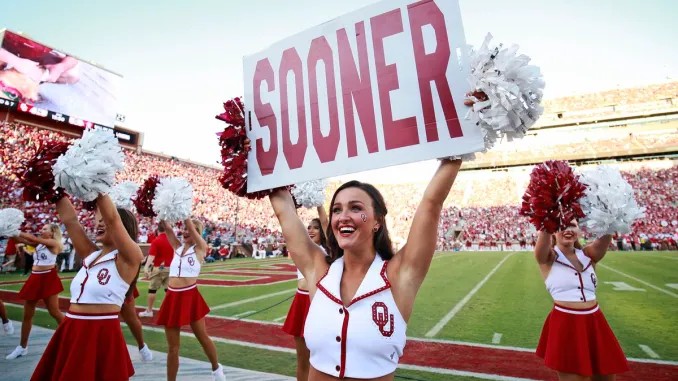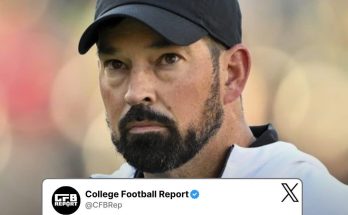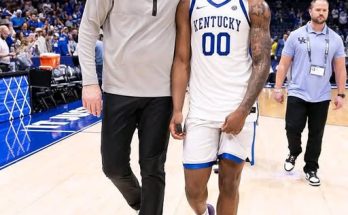In a moment destined to be etched in the history of collegiate sports, the Oklahoma Sooners cheerleading squad has captured the world’s attention by doing what many considered unthinkable: defeating the storied University of Kentucky squad to earn the coveted title of “World’s Best Cheerleading Squad,” as crowned by ESPN. The announcement sent shockwaves through the cheerleading and collegiate sports communities, and it marked a turning point in a sport often overlooked for its athleticism, precision, and cultural impact. For Oklahoma, this wasn’t merely a victory in a routine competition; it was a bold statement of excellence, artistry, and the culmination of years of relentless effort, evolving strategy, and team cohesion.
To grasp the significance of this triumph, one must first understand the dominance of the University of Kentucky in the world of cheerleading. Long considered the gold standard in the sport, Kentucky’s cheerleading program has historically embodied a flawless combination of technical mastery, athletic grit, and unwavering confidence. With multiple national championships under their belt and an aura of invincibility that intimidated even the most talented opponents, the Wildcats were the dynasty against which every other squad measured itself. Their routines were crisp, gravity-defying, and synchronized to perfection. Their legacy loomed so large that, for years, many considered the crown of “world’s best” to be permanently reserved for them.
That is what makes Oklahoma’s triumph all the more impressive. The Sooners did not just win; they redefined the standards by which cheerleading excellence is judged. ESPN’s decision to bestow the title of “World’s Best Cheerleading Squad” followed an international exhibition and scoring system that evaluated performances across multiple categories: technical difficulty, creativity, execution, crowd engagement, and innovation. Oklahoma scored the highest composite rating ever recorded, surpassing Kentucky’s previous mark by a staggering 3.5 points—a margin unheard of in this tightly contested sport.
The performance that sealed the deal for Oklahoma was nothing short of breathtaking. In a packed arena filled with roaring fans, judges, and live ESPN cameras broadcasting globally, the Sooners executed a routine that fused modern choreography with traditional cheer foundations. The complexity of their stunts defied belief: from synchronized basket tosses reaching new vertical heights, to acrobatic tumbling passes that demanded elite-level gymnastics training, to pyramids that seemed to rewrite the laws of balance and human coordination. But what truly separated Oklahoma from the rest was their emotion. Every smile, every chant, every perfectly timed clap and lift told a story—not just of school spirit, but of a squad that believed in each other with fierce conviction. Their routine didn’t just entertain—it moved the audience.
It’s important to recognize the mastermind behind this historic achievement: head coach Taryn McAllister, a former collegiate cheerleader herself who took over the Sooners program six years ago. When she arrived, Oklahoma had potential but lacked the consistency and creative identity to challenge the top programs. McAllister set out to change that culture, focusing not only on skill development but also on forging a bond of trust among her athletes. She emphasized innovation in choreography and conditioning regimens that mirrored Olympic-level training. Her belief was simple but revolutionary: that cheerleaders should be seen as elite athletes, with the same dedication, strategy, and performance rigor expected in football or basketball. Her philosophy resonated, and the team began to rise. Season after season, they edged closer to the top, learning from defeats and retooling their approach. This year, everything clicked.
What makes this story even more compelling is the makeup of the Oklahoma squad. The team is composed of a diverse group of athletes from across the country—some recruited from traditional cheer hotbeds like Texas and California, others walk-ons who earned their place through sheer determination. Many of them have backgrounds in gymnastics, dance, or competitive cheer, and each brought a unique element to the team’s dynamic. In interviews, they spoke frequently about the sacrifices made: early morning practices before classes, weekend travel for training camps, injuries fought through, and a shared commitment to representing their school with pride. What unites them isn’t just talent, but an uncommon level of discipline and camaraderie.
The championship moment was made even more powerful by the reaction of the Kentucky squad. As perennial champions, the Wildcats knew what it meant to win and to lose. And in the moment of defeat, they showed the highest degree of sportsmanship—applauding their rivals and acknowledging the excellence they had witnessed. For a sport often misunderstood as secondary or recreational, this showdown was a definitive statement: cheerleading is competitive, exhilarating, and demands more physicality and teamwork than many realize.
ESPN’s coverage of the event amplified its global reach. With cameras capturing not just the routines but behind-the-scenes glimpses into training sessions, emotional huddles, and post-performance tears, the world got a rare look at the lives of collegiate cheerleaders. Social media exploded with clips of Oklahoma’s gravity-defying stunts and heartfelt celebrations, and the hashtag #SoonerStunners trended for days. Celebrities, athletes, and alumni weighed in, praising the squad’s dedication and celebrating what many called “a victory for the underdog.” Even sports analysts unfamiliar with the cheer circuit found themselves impressed by the precision and athleticism on display.
Beyond the glitter and trophies, this victory carries broader implications for cheerleading as a sport. For too long, it has been dismissed as ancillary entertainment, rather than recognized for the competitive and physically demanding activity it is. Oklahoma’s win, broadcast and validated by a major sports network, is a step toward correcting that perception. It may even pave the way for more resources, scholarships, and institutional support for collegiate cheerleading programs across the country. The fact that the title of “World’s Best” was awarded by ESPN gives the achievement mainstream legitimacy and opens the door for greater visibility and respect for athletes in this space.



